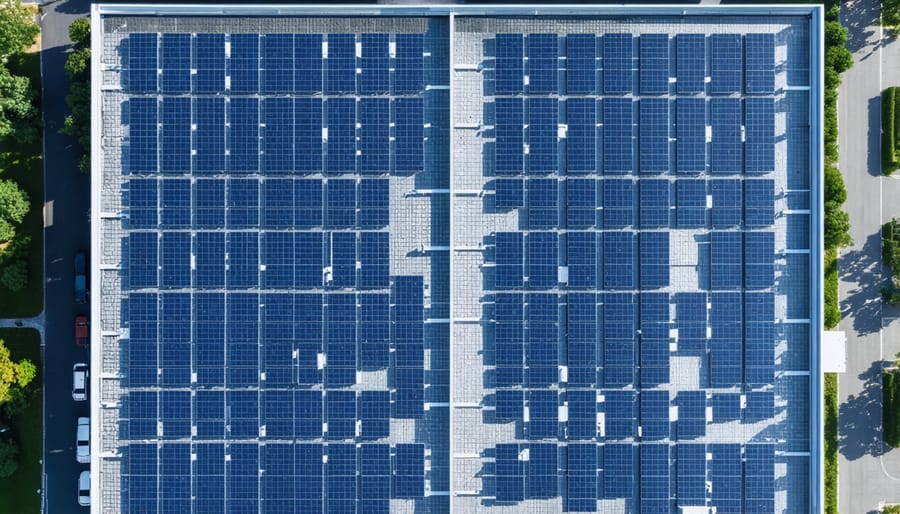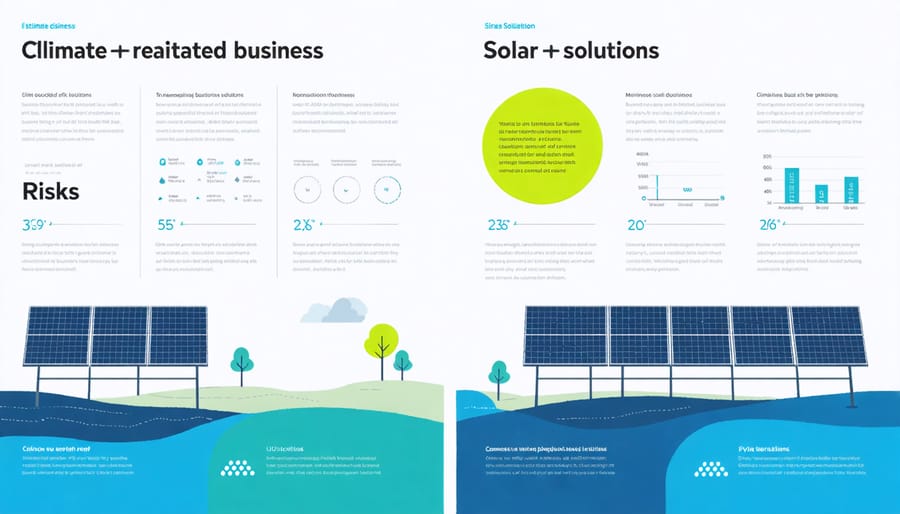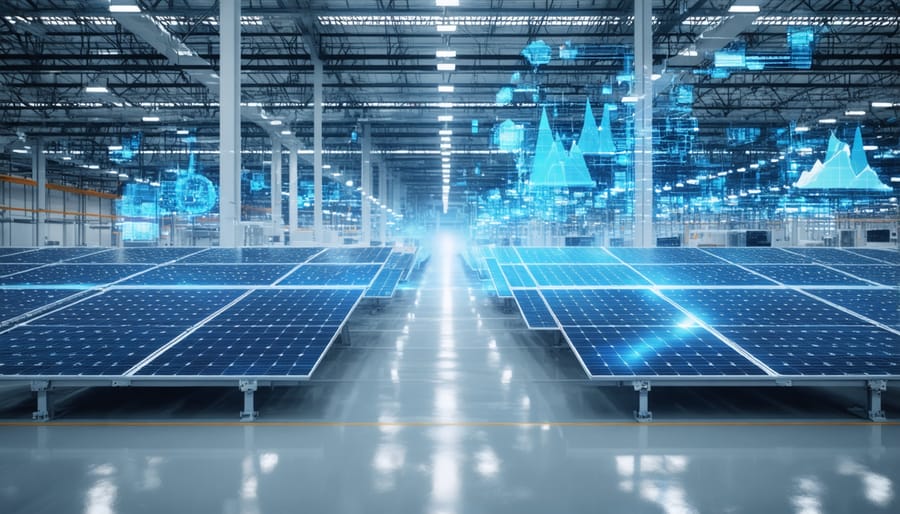The global transition to renewable energy represents more than an environmental imperative—it’s becoming a defining factor in business competitiveness and long-term economic resilience. As climate change accelerates, forward-thinking organizations are leveraging green energy solutions to simultaneously address environmental challenges and capture significant market advantages. Recent data from the International Energy Agency shows that renewable energy installations reached record levels in 2023, with businesses driving nearly 75% of new commercial solar and wind projects. This surge in corporate renewable adoption isn’t just about environmental stewardship; it’s reshaping industrial landscapes, creating new economic opportunities, and establishing a blueprint for sustainable growth in an increasingly carbon-constrained world. For business leaders and policymakers, understanding the intersection of green energy deployment and climate adaptation has become essential for strategic planning, risk management, and maintaining competitive advantage in a rapidly evolving global marketplace. The convergence of declining renewable technology costs, supportive policy frameworks, and escalating climate risks has created an unprecedented opportunity for organizations to lead the charge toward a more sustainable and prosperous future.

The Business Case for Green Energy Adoption
Financial Benefits of Solar Installation
Installing solar power systems offers substantial financial returns through multiple revenue streams and cost-saving mechanisms. Studies show that commercial solar installations typically achieve ROI within 3-7 years, demonstrating how businesses win with renewable energy investments. The federal Investment Tax Credit (ITC) currently provides a 30% tax reduction on total system costs, while many states offer additional incentives and rebates.
Organizations can expect to reduce their electricity costs by 50-75% immediately after installation, with monthly savings ranging from $500 to $5,000 depending on system size and local utility rates. Net metering programs allow businesses to sell excess power back to the grid, creating an additional revenue stream. The typical commercial solar system maintains 80% efficiency for 25-30 years, providing predictable energy costs and protection against rising utility rates.
Modern solar installations also increase property values by an average of 4%, while requiring minimal maintenance costs – typically less than 1% of the system’s value annually. When combined with energy storage solutions, the financial benefits increase further through peak demand reduction and enhanced grid independence.
Climate Resilience Through Energy Independence
Solar power installations are emerging as a crucial component of climate resilience strategies, offering protection against increasingly frequent extreme weather events and grid vulnerabilities. By implementing on-site solar generation, organizations can maintain critical operations during power outages and reduce dependency on centralized electricity infrastructure.
Recent examples demonstrate this resilience in action. During Hurricane Sandy, solar-equipped facilities in New York maintained power while surrounding areas experienced extended blackouts. Similarly, California businesses with solar-plus-storage systems have continued operations during planned power shutoffs designed to prevent wildfires.
The combination of solar panels and battery storage creates a robust microgrid system that can operate independently from the main power grid. This autonomy proves invaluable during natural disasters, cyber threats, or infrastructure failures. Organizations can maintain essential services, protect valuable assets, and minimize financial losses during grid disruptions.
Beyond emergency preparedness, energy independence through solar power provides daily operational benefits. It stabilizes energy costs, reduces peak demand charges, and creates a reliable power supply that supports business continuity in an increasingly unstable climate environment.
Commercial Solar Solutions for Climate Adaptation
Advanced Solar Technologies
Recent advancements in solar technology have revolutionized the commercial energy landscape, offering unprecedented efficiency and versatility. Bifacial solar panels, which capture sunlight from both sides, demonstrate up to 30% higher energy yield compared to traditional modules, making them particularly effective for large-scale installations.
Perovskite solar cells represent a significant breakthrough, achieving conversion efficiencies exceeding 25% while substantially reducing manufacturing costs. Major manufacturers are now incorporating this technology into their production lines, with commercial deployment expected within the next two years.
Building-integrated photovoltaics (BIPV) have evolved beyond simple roof installations. Modern solar glass and solar facades seamlessly integrate into building designs, transforming entire structures into power generators while maintaining aesthetic appeal. The Four Times Square building in New York demonstrates this technology’s potential, generating 15% of its total energy needs through solar facades.
Floating solar farms (floatovoltaics) address land-use concerns while offering enhanced efficiency through water cooling effects. The world’s largest installation in China’s Anhui Province generates 150 megawatts of power and serves as a model for similar projects globally.
Smart solar tracking systems, equipped with AI-driven optimization algorithms, can increase energy yield by up to 25% compared to fixed installations. These systems automatically adjust panel orientation throughout the day, maximizing power generation and improving return on investment for commercial installations.

Integration with Existing Infrastructure
Integrating renewable energy systems into existing commercial infrastructure requires strategic planning and careful consideration of building characteristics. Modern solar solutions for existing buildings can be implemented through various approaches, minimizing disruption to ongoing operations while maximizing energy efficiency gains.
Key integration strategies include rooftop solar installations with reinforced mounting systems, building-integrated photovoltaics (BIPV) that replace conventional building materials, and ground-mounted solar arrays for properties with available land. Smart energy management systems enable seamless coordination between new solar installations and existing power infrastructure, ensuring optimal performance and reliable power distribution.
Successful implementation often involves conducting comprehensive site assessments, evaluating structural integrity, and analyzing current energy consumption patterns. Organizations should also consider grid connection requirements, local building codes, and potential system upgrades needed to accommodate renewable energy integration.
Many facilities achieve optimal results through a phased implementation approach, starting with pilot projects in specific areas before expanding to full-scale deployment. This method allows for proper testing and adjustment of systems while maintaining business continuity. Integration can also incorporate energy storage solutions, such as battery systems, to enhance reliability and maximize the benefits of solar power generation during peak demand periods.
Real-World Success Stories

Manufacturing Sector Implementation
The Johnson Manufacturing facility in Michigan demonstrates the transformative potential of solar energy in industrial settings. In 2021, the 250,000-square-foot facility completed a comprehensive solar installation project, covering 80% of their roof space with high-efficiency photovoltaic panels.
The installation, comprising 1,200 solar panels, generates 850,000 kWh annually, meeting approximately 60% of the facility’s energy requirements. The project required an initial investment of $1.8 million but secured $500,000 in federal tax incentives and state grants, significantly reducing the overall costs.
Within 18 months of implementation, the facility reported a 45% reduction in energy costs, projecting complete ROI within six years. Additionally, the installation reduced carbon emissions by 600 metric tons annually, equivalent to removing 130 cars from the road.
The success prompted Johnson Manufacturing to implement similar systems across three additional facilities, creating a blueprint for sustainable manufacturing operations. The project also improved the company’s Environmental, Social, and Governance (ESG) metrics, attracting environmentally conscious investors and customers while strengthening their market position.
Commercial Real Estate Solar Integration
The adoption of solar energy in commercial real estate has emerged as a game-changing strategy for property owners and managers. A prime example is the Meridian Corporate Plaza in Denver, which implemented a comprehensive solar integration project in 2021. The 250,000-square-foot office complex reduced its energy costs by 45% within the first year of installation, while increasing property value by $2.8 million.
The success extends beyond immediate cost savings. Tenants report higher satisfaction rates due to reduced operating expenses and enhanced environmental credentials, leading to improved occupancy rates and longer lease terms. The project’s payback period of 4.5 years, accelerated by federal tax incentives and local utility rebates, demonstrates the compelling financial case for commercial solar adoption.
Building owners are increasingly leveraging solar installations as a competitive advantage. Modern solar solutions, including building-integrated photovoltaics (BIPV) and smart energy management systems, enable properties to achieve both sustainability goals and operational efficiency. This transformation is particularly evident in markets where green building certifications command premium rental rates and attract environmentally conscious corporate tenants.
Future-Proofing Your Business with Renewable Energy
Energy Management Strategies
Modern solar energy management requires sophisticated strategies that leverage both technology and data analytics to maximize efficiency. Smart inverter systems with advanced monitoring capabilities enable real-time optimization of solar power generation and consumption patterns. These systems integrate seamlessly with building management software to automatically adjust energy usage based on peak production periods and demand fluctuations.
Energy storage solutions play a crucial role in optimizing solar power utilization. By implementing intelligent battery management systems, organizations can store excess energy during peak production hours and deploy it strategically during high-demand periods or when solar generation is low. This approach significantly reduces dependency on grid power and maximizes return on investment.
Load shifting and demand response programs represent another frontier in renewable energy innovation. By analyzing consumption patterns and weather forecasts, facility managers can schedule energy-intensive operations during optimal solar production hours, ensuring maximum utilization of clean energy resources.
Predictive maintenance algorithms help prevent system inefficiencies before they impact performance. These tools monitor panel degradation, identify potential maintenance issues, and optimize cleaning schedules to maintain peak efficiency. Additionally, advanced metering infrastructure provides detailed insights into energy consumption patterns, enabling data-driven decisions for continuous system optimization and enhanced energy management strategies.
Scaling Solar Solutions
As businesses increasingly adopt solar energy solutions, scaling becomes a critical consideration for long-term success. The key to effective scaling lies in implementing a phased approach that aligns with organizational growth and energy demands. Start by conducting a comprehensive energy audit to establish current usage patterns and projected needs, which will inform your scaling strategy.
Modular solar installations offer excellent flexibility for expansion. Begin with a base system that meets immediate requirements while ensuring the infrastructure can support future additions. This includes selecting inverters with sufficient capacity for growth and installing appropriate electrical infrastructure during initial implementation.
Consider these proven scaling strategies:
1. Reserve adequate roof or ground space for future panel installations
2. Install oversized conduit and wiring to accommodate additional capacity
3. Choose scalable monitoring systems that can integrate new components
4. Plan for energy storage expansion with compatible battery systems
Leading organizations typically implement a 3-5 year scaling roadmap, incorporating regular assessments of energy consumption patterns and technological advancements. This approach allows for strategic capacity increases while maximizing ROI at each stage.
A notable success story is the Metro Distribution Center, which started with a 500kW system and systematically expanded to 2MW over four years, achieving 40% reduced energy costs while maintaining operational continuity throughout the scaling process.
Remember to factor in local utility regulations and available incentives when planning expansions, as these can significantly impact project economics and implementation timelines.
As businesses navigate the challenges of climate change, implementing solar energy solutions has emerged as a crucial strategy for building long-term resilience. The transition to solar power not only addresses environmental concerns but also provides significant economic advantages through reduced operational costs and enhanced energy independence.
To successfully integrate solar energy into business operations, organizations should begin with a comprehensive energy audit to understand their consumption patterns and identify optimal solar installation opportunities. Following this, developing a phased implementation plan that aligns with budgetary constraints and organizational goals ensures a smooth transition while maximizing ROI.
Key action steps include securing appropriate financing through available government incentives and private sector programs, partnering with certified solar installers who understand commercial applications, and establishing clear metrics for measuring system performance and environmental impact.
Companies should also consider implementing energy management systems to optimize solar power usage and integrate it effectively with existing operations. Regular maintenance schedules and performance monitoring will ensure maximum system efficiency and longevity.
By taking these strategic steps, businesses can significantly reduce their carbon footprint while building resilience against future energy cost fluctuations and regulatory changes. The investment in solar technology positions organizations as environmental leaders while providing tangible benefits in terms of operational efficiency and sustainable growth.
Remember that successful solar adoption requires ongoing commitment and adaptation to new technologies and best practices. As the renewable energy landscape continues to evolve, staying informed and flexible will be crucial for maintaining competitive advantage and environmental responsibility.

